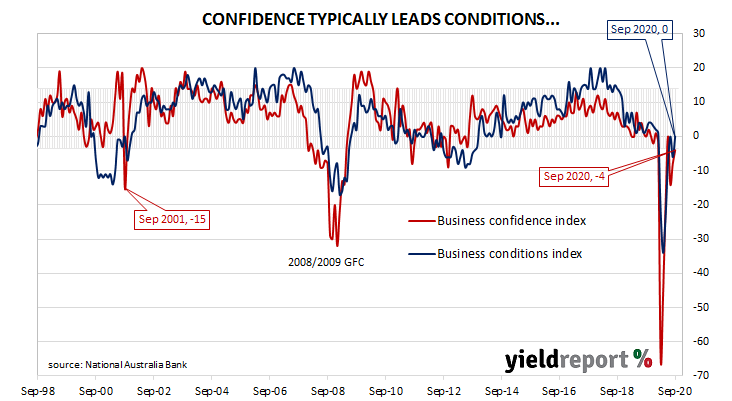Summary: Business conditions, confidence improve; conditions “notably weaker” in Victoria, some states now above average; capacity usage rises after August reversal; forward-looking indicators “soft”.
NAB’s business survey indicated Australian business conditions were robust in the first half of 2018, with a cyclical-peak reached in April of that year. Readings from NAB’s indices then began to slip, declining to below-average levels by the end of 2018. Forecasts of a slowdown in the domestic economy began to emerge in the first half of 2019 and the indices trended lower, hitting a nadir in April 2020 as pandemic restrictions were introduced. Conditions have improved markedly since then.
According to NAB’s latest monthly business survey of over 400 firms conducted in the middle of September, business conditions recovered all of August’s deterioration. NAB’s conditions index registered 0, up from August’s reading of -6.
Business confidence improved for a second consecutive month. NAB’s confidence index rose from August’s reading of -8 to -4. Typically, NAB’s confidence index leads the conditions index by approximately one month, although some divergences have appeared in the past from time to time.
“The impact of the virus remains evident in Victoria where conditions are notably weaker than the other states. On the other hand, conditions are now above average in Western Australia, South Australia and Queensland pointing to an ongoing recovery in those states. New South Wales remains negative but also improved in the month,” said NAB chief economist Alan Oster.

NAB’s report came out on the same day as the Melbourne Institute’s latest Inflation Gauge release and Commonwealth bond yields moved higher, to some degree following US Treasury yields in overnight trading. By the end of the day, the 3-year ACGB yield had crept up 1bp to 0.22%, the 10-year yield had increased by 5bps to 0.88% while the 20-year yield finished 1bp higher at 1.42%.

